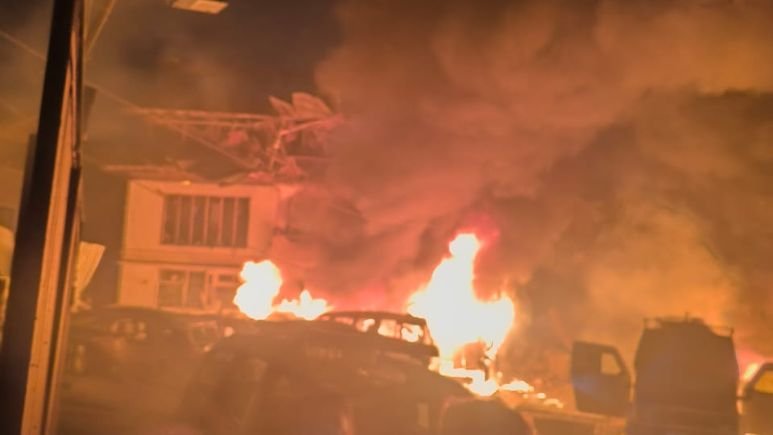attention to one of the most overlooked aspects of counter-terror operations how seized explosives are stored, examined, and neutralized.
The blast, which killed police personnel, forensic staff, and government workers, has sparked urgent conversations about safety procedures in high-risk zones like Jammu & Kashmir.
What Happened at the Nowgam Police Station
The explosion occurred while teams were inspecting a set of explosives recovered during a recent counter-terror operation linked to a network stretching from Faridabad to Kashmir.
Officials reported that the devices included improvised explosive materials and large amounts of ammonium nitrate, which were being evaluated for forensic evidence when the blast erupted.
The impact was severe:
- The police station’s examination area was destroyed
- Vehicles parked nearby were reduced to debris
- Over two dozen individuals suffered injuries
- Several families lost members working on the frontline of forensic and security duties
This tragic event happened in a region already under heightened alert due to repeated attempts by terror outfits to smuggle explosives and plot attacks.
What the Blast Reveals: Key Lessons for Handling Seized Explosives
The Nowgam incident lays bare several gaps in how seized explosive materials are processed. These issues are not unique to J&K but represent systemic shortcomings across many Indian states.
1. High-risk explosives should never be stored in regular police stations
Police stations in populated areas are not designed for:
- Blast containment
- Shock resistance
- High-temperature exposure
- Isolation from civilian neighbourhoods
National guidelines recommend shifting explosives to designated ammunition depots or specialized defence facilities within hours of seizure. The Nowgam case shows what can happen when these rules are not enforced.
2. Forensic work must be carried out in controlled environments
Explosive examination ideally requires:
- Blast-proof chambers
- Robotic or remotely triggered tools
- Isolation from administrative buildings
- Trained explosive-handling units
Even skilled forensic staff face unacceptable risks without such infrastructure.
3. The chain of custody must include structured safety checks
Before any forensic assessment, seized items should undergo:
- Preliminary stability tests
- Chemical profiling
- Safe transfer procedures
- Independent inspection by a bomb disposal team
Skipping any of these checks can turn a routine analysis into a fatal event.
Strengthening Safety Protocols in High-Threat Regions
The Nowgam blast serves as a nationwide warning. Here are the areas where immediate improvements are needed:
1. Mandatory annual safety audits
Police stations in sensitive areas must be evaluated on:
- Storage practices
- Emergency response readiness
- Building safety and blast resilience
- Availability of bomb disposal equipment
These audits must be made public to ensure accountability.
2. Modern containment technology
Many nations now use blast-proof cabinets and detonation-safe vaults, which:
- Absorb shock waves
- Protect surrounding structures
- Allow remote testing of samples
- Reduce human involvement
In a region like J&K, this equipment is not optional it is essential.
3. Centralized explosive storage with military oversight
A joint system involving:
- J&K Police
- CRPF
- Indian Army
- National Investigation Agency
…would ensure that dangerous materials are transported and stored under professional supervision.
4. Digitized inventory and intelligence integration
A secure digital registry can reduce misplacement, mishandling, or accidental duplication of explosive material entries. Integration with national cyber and intelligence grids will help track patterns across states.
Terror Threat Landscape: Why Explosive Seizures Have Become More Frequent
The rise in explosive-related incidents across Jammu & Kashmir aligns with broader changes in the tactics of regional militant groups.
Shift toward locally assembled IEDs
Ingredients like:
- Ammonium nitrate
- Gelatin sticks
- Pressure mechanisms
- Remote detonators
…are increasingly being sourced locally or repurposed from industrial supplies.
Smaller, decentralized terror modules
Recent arrests show involvement of:
- Radicalized medical professionals
- Skilled technicians
- Individuals recruited through encrypted online networks
These groups operate in smaller cells, making detection harder and seizures more irregular but more dangerous.
Proxy involvement
Intelligence agencies have pointed to:
- Jaish-e-Mohammed affiliates
- PAFF (People’s Anti-Fascist Front)
- Other Pakistan-linked handlers
…attempting to push operatives into India or direct locals through anonymous handlers.
This makes routine tasks like evidence handling significantly riskier, as no explosive cache can be considered “stable” or harmless.
Action Plan: What Needs to Change After the Nowgam Blast
1. Immediate policy amendments
Recommendations under review include:
- Banning long-term storage of explosives at police stations
- Fast-track movement of volatile materials to military facilities
- Compulsory bomb disposal presence during major investigations
2. Better training for police and forensic teams
Training must go beyond classroom instruction to include:
- Live simulations
- Multi-agency drills
- Scenario-based explosive handling
- Safety-first protocols
3. Technology and automation
Remote systems such as:
- Bomb robots
- Drone-based detection
- X-ray explosive scanners
- AI-supported threat analysis
…significantly reduce human exposure to risk.
4. Community safety and public awareness
Locals need clear guidance on:
- Identifying suspicious objects
- Reporting abandoned bags
- Emergency evacuation routes
- Staying informed during active operations
Public-level preparedness can often prevent or limit the damage caused during emergencies.
Lessons for Police Stations Across India
The Nowgam tragedy underscores several truths:
- Explosive safety cannot rely on “experience” it must rely on protocol
- Even trained personnel are vulnerable when working in unsafe environments
- India needs uniform handling procedures across all states
- Technology adoption is no longer optional
- Multi-agency coordination saves lives
This blast should not be seen as an isolated event but as a catalyst for long-overdue reforms.
Conclusion
The Jammu Kashmir police station blast is a grim reminder of the risks faced by law enforcement officers working on the frontline of national security.
It exposes systemic vulnerabilities in how seized explosives are processed and highlights the urgent need for better training, technology, and infrastructure.
Preventing another such tragedy requires more than temporary responses. It requires a permanent shift in safety culture across India’s security and forensic ecosystem.


